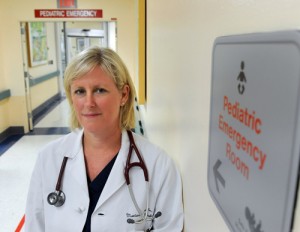Emergency departments improve readiness to care for children

Pediatric emergency care coordinators in the nation’s emergency departments are strongly linked with improved readiness to care for children, according to a new study in . Nearly 50 percent of the nation’s emergency departments have a physician or nurse dedicated to address staff training, equipment availability and policies for the care of children—a three-fold increase since 2003. This is an important finding because the presence of a pediatric emergency care coordinator is strongly correlated with improved pediatric readiness, independent of other factors.
“Emergency department pediatric readiness has improved greatly since a similar assessment was conducted in 2003,” said study author Marianne Gausche-Hill, MD, FACEP, FAAP, of the Los Angeles Biomedical Research Institute at Harbor-UCLA Medical Center. The nation’s overall pediatric readiness score, out of 100, increased to nearly 70 (up from 55 in 2003).
According to Dr. Gausche-Hill, 4,149 emergency departments (83 percent) took the assessment, compared with 29 percent in 2003. “The strong response rate reflects the commitment by emergency providers to improve emergency care for children.”
The assessment found that emergency departments have 91 percent of recommended pediatric equipment readily available, as defined in the joint policy statement issued by the American Academy of Pediatrics, the American College of Emergency Physicians and the Emergency Nurses Association in 2009.
“The assessment tool was designed to assist hospitals to self-measure levels of pediatric equipment availability, coordination of pediatric emergency care issues, as well as the availability of essential policies for children in emergency departments,” said Dr. Gausche-Hill.”The results provide a better understanding of emergency department pediatric readiness, identify opportunities to continue to improve pediatric emergency care, and highlight the important role of pediatric emergency care coordinators in ensuring pediatric readiness of emergency departments.”
According to the assessment, the areas for improvement include:
Disaster Plans. Only 47 percent of respondents had a disaster plan that addresses issues specific to the care of children.
Equipment. At least 15 percent of emergency departments lacked one or more specific pieces of equipment as recommended by the 2009 guidelines, such as pediatric Magill forceps for removal of airway foreign bodies.
Guidelines Implementation. Nearly 81 percent of respondents reported barriers to guidelines implementation. The most frequent barriers reported were cost of training personnel (54 percent) and lack of educational resources (49 percent).
Dr. Gausche-Hill said this effort shows how national collaborative efforts are driving measurable improvements in readiness to handle pediatric emergencies across the nation.
The electronic assessment was conducted from January to August 2013 by organizations that are leading a quality improvement initiative to further enhance pediatric readiness in emergency departments. The organizations are the American Academy of Pediatrics, the American College of Emergency Physicians, the Emergency Nurses Association and the Health Resources and Service Administration’s Emergency Medical Services (EMS) for Children Program.
About LA BioMed
Founded in 1952, LA BioMed is one of the country’s leading nonprofit independent biomedical research institutes. It has approximately 100 principal researchers conducting studies into improved treatments and therapies for cancer, inherited diseases, infectious diseases, illnesses caused by environmental factors and more. It also educates young scientists and provides community services, including prenatal counseling and childhood nutrition programs. LA BioMed is academically affiliated with the David Geffen School of Medicine at UCLA and located on the campus of Harbor-UCLA Medical Center. For more information, please visit www.LABioMed.org
